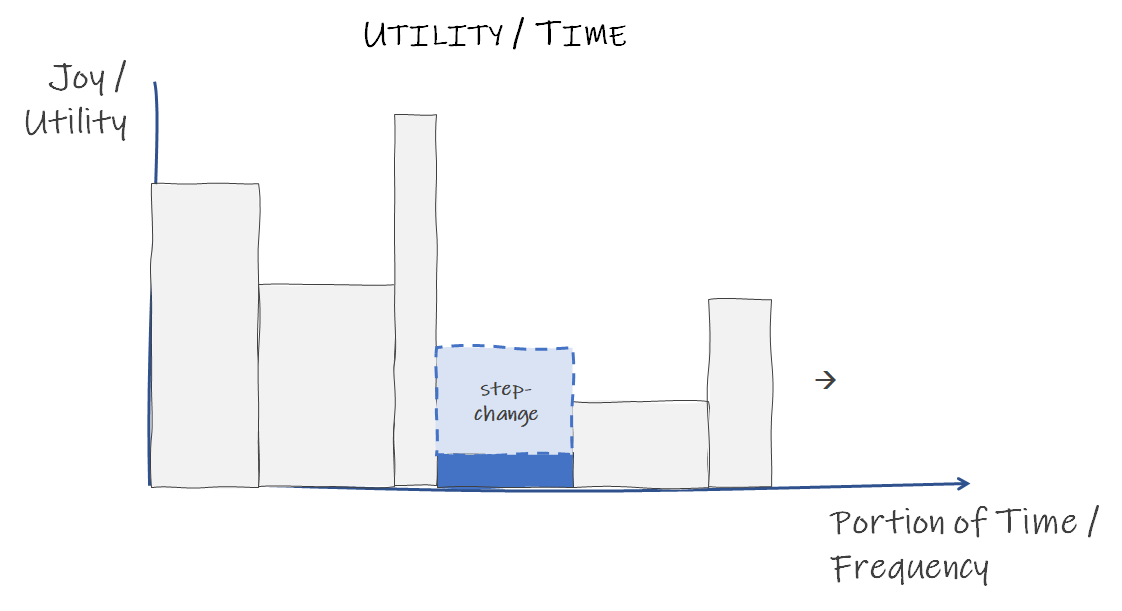Musings #6
Step-Change Change
One thing I love is when I discover something in my life that can be a step-change better.
It is even more delightful when that something is a mundane or regular occurrence, because that’s when the effect of a step-change is greatest. If you can take the joy or utility of doing something from near 0 and improve it to 1, and the frequency of that activity is high, then you are taking a large block of zero-joy activity and turning it into something that generates significantly more value.

A step-change change x high frequency = huge impact.
For example, I recently started changing my habits relating to sunlight. Specifically, going outside first thing in the morning and again just before sunset. Per this very enlightening podcast from Huberman Lab on Maximizing Productivity, Physical & Mental Health with Daily Tools:
Getting sunlight in your eyes first thing in the morning is absolutely vital to mental and physical health. It is perhaps the most important thing that any and all of us can and should do in order to promote metabolic well-being, promote the positive functioning of your hormone system, get your mental health steering in the right direction.
This block of time was otherwise not distinguishable from the rest of my day, but now it has made a remarkable change in my health and mood.
Health is a fertile ground for step-change improvements, although there are many ways that even seemingly less important things can be made better and make a difference. It can something you consume or even a software tool that makes your life easier.
My friends are probably tired of me raving about this, but my morning coffee went from a routine event to something joyful thanks to Cometeer (my referral link is here if you want a discount).
Discovering you.com, as I wrote about in Musings #5, has been a step-change for me in something I do frequently (searching the internet). It may seem trivial, but search was previously a zero joy and low utility endeavor that I do dozens of times a day, and now it is continually a delightful experience. Same thing with other software tools I use daily such as Notion.so. Value created from something mundane but frequent.
The other lesson in the utility/time chart above is that to increase your area Under the Curve, a crucial ingredient is a willingness to try new things and experiment. That’s something I need to be proactive about because human nature is to get set in your ways, so I make a point of trying new products and tech to see what sticks. In that vein, if you’ve tried something new recently that is a step-change change, I’d love to hear about it.
Things not Experiences?
For a long time, I have generally subscribed to the common thinking of “buy experiences, not things.” Makes sense: focus on experiences and creating memories over buying material goods. Who could argue with that?
But I recently read a fascinating piece that argues for the exact opposite. And it makes a pretty good case. From Buy Things, Not Experiences:
While I appreciate the Stoic-style appraisal of what really brings happiness, economically, this analysis seems precisely backward. It amounts to saying that in an age of industrialization and globalism, when material goods are cheaper than ever, we should avoid partaking of this abundance. Instead, we should consume services afflicted by Baumol’s cost disease, taking long vacations and getting expensive haircuts which are just as hard to produce as ever.
The author makes two other good points. First, that advocates of experiences tend to be urbanites who can’t afford or don’t have space for things, so it is “less a bold new philosophy than a mere rationalization of life choices that people have already been forced to adopt.”
Second, and this is where a crucial distinction comes in, is that things can enable experiences:
But what this rationalization ignores is the extent to which tools and possessions enable new experiences. A well-appointed kitchen allows you to cook healthy meals for yourself rather than ordering delivery night after night. A toolbox lets you fix things around the house and in the process learn to appreciate how our modern world was made.
Thus, to me, the key point is not to overconsume material things and aspire for luxury goods, but rather to be more willing to buy things that actually bring you happiness, utility, and enable experiences. And on the other end, a distinction can also be made about experiences:
In truth, there is no real boundary between things and experiences. There are experience-like things; like a basement carpentry workshop or a fine collection of loose-leaf tea. And there are thing-like experiences, like an Instagrammable vacation that collects a bunch of likes but soon fades from memory.
Founder Ownership
CEO ownership at some founder led tech companies over time (since founding) pic.twitter.com/zvh4pISw6u
— Bread Crumbs Research 🇺🇦 (@breadcrumbsre) December 7, 2021
This chart has a lot of interesting threads. One obvious one is that (economic) ownership trends down due to actually selling shares, as well as being diluted from financings, acquisitions, and stock-based compensation. But the slopes really vary and this makes a significant difference in value realization, especially given how most of these stocks have performed extremely well. Amazon really stands out as maintaining much higher CEO ownership over time.
Another interesting point, as the author notes in the replies, is NVDA is pretty much the only one to ever have an increase in CEO ownership, which in retrospect was a strong signal as this was right before the stock went on a historic run.
Curveballs
I capture highlights from all the things I read. A few noteworthy ones of late:
-
“Reading twenty books a year gets you a lot. Consider: one book gives you more knowledge about a subject than almost every other person on the planet, because people don’t read. Two books on the same subject give you more knowledge than almost any reader, because people don’t read two books about the same thing.” - How I read (Slava Akhmechet)
-
“Ultimately I learned the greatest joy of sport for me also lies in the challenge. When you come to this realization, you can wish your competitors well and even help them perform to the best of their abilities. In the end what you’re also doing is adding to your own experience and sense of accomplishment.” - The Tao of Sport (Duff Gibson)
-
“Kimo’s high expectations set a new pace for me. He taught me that “the standard pace is for chumps” — that the system is designed so anyone can keep up. If you’re more driven than most people, you can do way more than anyone expects. And this principle applies to all of life, not just school.” - There’s no speed limit (Derek Sivers)
Photography
One nice side-benefit of my new daily habit of getting outside more during the day is more opportunities for my photography hobby. A few recent ones: s
